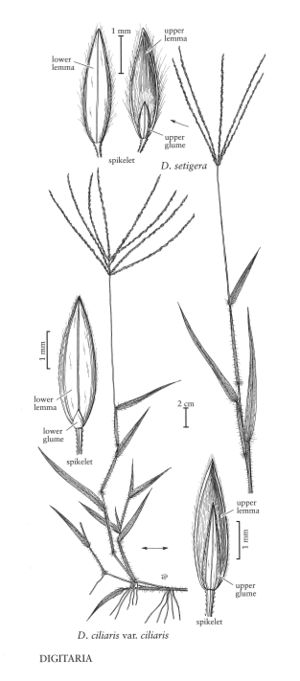Digitaria ciliaris
Plants annual or of indefinite duration. Culms 10-100 cm long, erect portion 30-60 cm, long-decumbent, rooting and branching at the decumbent nodes, sparingly branched or unbranched from the upper nodes; nodes 2-5, glabrous. Sheaths with papillose-based hairs; ligules 2-3.5 mm, erose; blades 1.5-14.4 (18.9) cm long, 3-9 mm wide, flat, glabrous, a few scattered papillose-based hairs at the base of the adaxial surfaces (occasionally over the whole adaxial surface), usually also scabrous on both surfaces. Panicles with 2-10 spikelike primary branches, these digitate or in 1-3 whorls on rachises to 2 cm; lowest panicle nodes with hairs more than 0.4 mm; primary branches 3-24 cm long, 0.6-1.2 (2) mm wide, glabrous or with less than 1 mm hairs, axes wing-margined, wings at least 1/2 as wide as the midribs, lower and middle portions of the branches bearing spikelets in unequally pedicellate pairs; secondary branches absent; shorter pedicels 0.5-1 mm; longer pedicels 1.5-4 mm. Spikelets (2.7) 2.8-4.1 mm long, homomorphic. Lower glumes 0.2-0.8 mm, acute; upper glumes (1.2) 1.5-2.7 mm, about 2/3 to almost as long as the spikelet, 3-veined, margins and apices pilose; lower lemmas 2.7-4.1 mm, 7-veined, veins unequally spaced, outer 3 veins crowded together near each margin, well-separated from the midvein, usually smooth, occasionally the lateral-veins scabridulous on the distal 1/3 margins and regions between the 2 inner lateral-veins hairy, hairs 0.5-1 mm (rarely glabrous), sometimes also with glassy yellow hairs between the 2 inner lateral-veins, these more common on the upper spikelets; upper lemmas 2.5-4 mm, glabrous, yellow, tan, or gray when immature, becoming brown, often purple-tinged (occasionally completely purple) at maturity; anthers 0.6-1 mm. 2n = 54.
Distribution
Conn., N.J., N.Y., Del., Pacific Islands (Hawaii), Fla., Puerto Rico, N.Mex., Tex., La., Tenn., Pa., Miss., N.C., Va., Md., Virgin Islands, Calif., Ala., Ark., Ill., Ga., Ind., Iowa, Ariz., Kans., Nebr., Okla., Mass., Ohio, Utah, Mo., S.C., Ky.
Discussion
Digitaria ciliaris is a weedy species, found in open, disturbed areas in most warm-temperate to tropical regions, primarily in the eastern United States. It is particularly abundant in the Southeast. So far as is known, the two varieties distinguished in the following key do not differ in any other characters. They are recognized here pending further study.
Selected References
None.
Lower Taxa
Key
| 1 | Lower lemmas without glassy yellow hairs | Digitaria ciliaris var. ciliaris |
| 1 | Lower lemmas with glassy yellow hairs | Digitaria ciliaris var. chrysoblephara |
